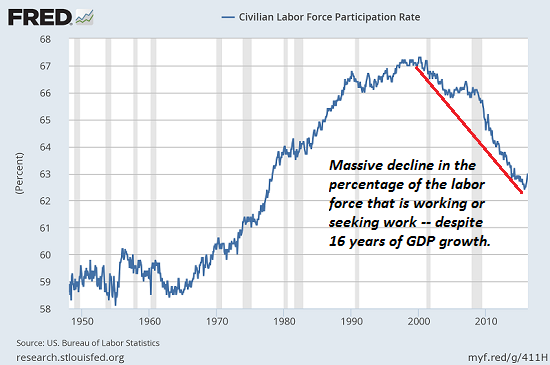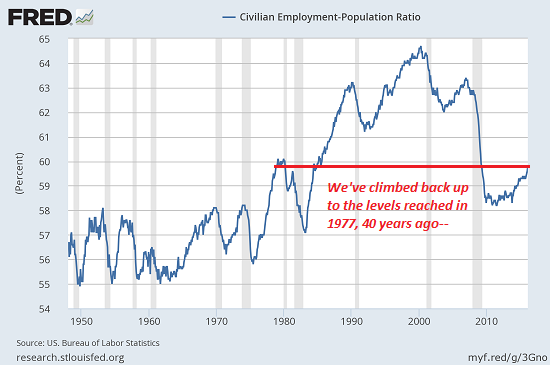Perceptions may well change when the global illusions of solvency and "growth" collapse in a heap.
The list of pundits jostling for air time to add their two cents to discussions of hot-button issues such as immigration is endless. The airwaves and social media are overflowing with people wanting to comment on hot-button social issues, but when it comes to the the one truly critical dynamic that will shape the future--everyone's strangely silent.
The reason nobody dares address this problem is that it has no solution within the current mode of production, i.e. the status quo. The problem is an oversupply of labor.
One of the key takeaways from historian Peter Turchin's new book
Ages of Discord is that
real wages stagnate or decline in periods of labor oversupply and rise in periods of labor shortages.
This is common sense: the price/value of everything is ultimately set by the dynamics of supply and demand: the price/value of anything that is overly abundant drops. Or put another way: if demand is outstripped by supply, prices decline as long as there is surplus supply.
If supply continues to exceed demand by a wide margin, price can drop to near-zero. Consider the cost of telephony bandwidth. With the advent of fiber optics, the quantity of bandwidth available globally for telephony far exceeded demand, and the cost of bandwidth fell to pennies.
What generates an oversupply of labor? David Hackett Fischer discussed the core demographic dynamic in
The Great Wave: Price Revolutions and the Rhythm of History: as labor productivity/land under production increases, food supplies increase. This increase supports a higher birth rate /population, and eventually the population of workers swells to the point that the supply of labor exceeds the demand for labor by employers.
Once the available productive land is under cultivation, the surplus population is pushed onto marginal lands that cannot reliably sustain high yields. The net results are famines and food shortages as crop failures on marginal lands are inevitable.
With labor in permanent surplus, wages stagnate or decline, and the result is a generalized immiseration of the laboring class that eventually leads to instability/upheaval.
In the current era, Turchin identifies three sources of surplus labor: the increase in population from birth rates above replacement levels; immigration and the mass movement of women into the work force after 1970.
Each of these demographic sources added tens of millions of laborers to the work force.
In periods of strong job growth, demand from employers is high enough to absorb the added supply of labor from native population growth and immigration. In periods of stagnant job growth, immigration adds to the oversupply of native labor from population expansion.
Common sense suggests high immigration becomes an economic issue when job growth no longer absorbs net native population expansion and the influx of immigrants.
The fourth dynamic generating labor supply/demand imbalances is automation.Though automation has been a dynamic force reducing the demand for human labor for hundreds of years, the pace has increased as software and robotics are now increasingly replacing higher-skill workers.
The First Industrial Revolution used water and steam power to mechanize production. The Second used electric power to create mass production. The Third used electronics and information technology to automate production. Now a Fourth Industrial Revolution is building on the Third, the digital revolution that has been occurring since the middle of the last century. It is characterized by a fusion of technologies that is blurring the lines between the physical, digital, and biological spheres.
As software eats the world, it eats higher-level skills that were once immune to automation. This means that the strategy that worked for 200 years--moving up the skill-value chain to tasks that could not be profitably automated--no longer works.
Few conventional economists/pundits understand this, or are willing to confess that the problem of permanent labor surplus cannot be solved by status quo policy tweaks. As I explain in my book, guaranteed minimum income is no solution--humans need the purpose, meaning and goals provided by meaningful work.
This why my book is subtitled The Future Belongs to Work That Is Meaningful.
If you still doubt labor is in permanent oversupply, please glance at these charts of the labor participation rate and the civilian employment/population ratio.
Over 90 million adults (out of a total population of 317 million) are counted as "not in the labor force," i.e. not working or seeking work due to disability, being in school, domestic duties, early retirement, etc.
The percentage of the population working or seeking work has fallen significantly.
There is a basic structural problem with supporting 100+ million non-employed adults. The economy has to be productive and profitable enough to support this vast populace without relying on debt, which is as we all know borrowing from future workers and taxpayers to fund consumption today.
Given the vast expansion of public and private debt since 2008, it's clear that we are not supporting the populace out of cash flow, so to speak; we're borrowing trillions of dollars from future workers/ taxpayers to generate the temporary illusion of solvency.
We need a new mode of production to generate meaningful work for all, and I've done my best to lay out a systemic solution. Right now this solution seems "crazy" to the conventional mindset, but
perceptions may well change when the global illusions of solvency and "growth" collapse in a heap.
Join me in seeking solutions by becoming a $1/month patron of my work via patreon.com.
NOTE: Contributions/subscriptions are acknowledged in the order received. Your name and email remain confidential and will not be given to any other individual, company or agency.
|
Thank you, Michael S. ($10/month), for your outrageously generous subscription to this site-- I am greatly honored by your support and readership.
| |



























